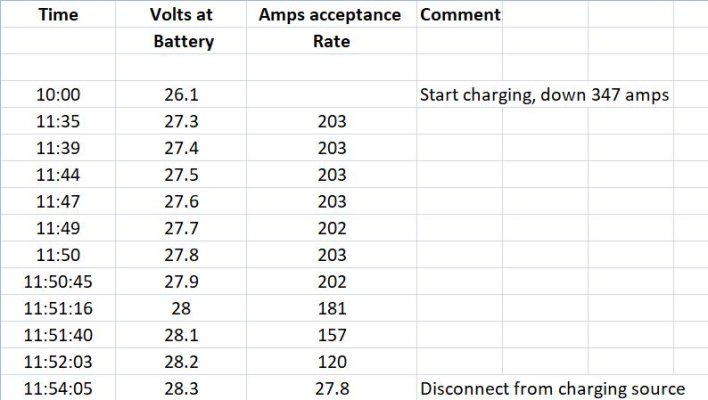MurrayM
Guru
Ahhh, the Internet. So many things to discover.....
Can anybody reference some independent third party testing of silicon dioxide batteries? So far all I can scare up is dealer and manufacturer information and some RV forum conversations.
Looks like they might be similar in many ways to Firefly's carbon foam batteries, but differ in that they can be charged at 14.7 rather than Firefly's 14.4 volts. It also appears they can take a full charge almost to 100% so don't need a smart three stage charging regime either. (Have emailed the company to confirm that one).
If it's true that three stage charging isn't needed, then it would save fuel if you needed a full charge...but if you didn't need a full charge, they don't suffer from sulfation either. Oh, and they only lose a tad over 1% of charge per month.
The 116 Ah Firefly G31 goes for $748.00 Cdn and the 108 Ah Si02 batteries from Azimuth Solar are on sale right now for $634.00 which makes for over $340.00 in savings over Firefly's when buying three batteries.
The savings over lithium batteries would be even more significant.
Sounding pretty good, eh? Too good to be true? This is why I would like to find a third party test!
Silicon Dioxide SiO2 Lead Crystal Batteries Extreme Temperature Deep Cycle Battery
https://soneil.com/products/battery/?swoof=1&product_cat=battery
Can anybody reference some independent third party testing of silicon dioxide batteries? So far all I can scare up is dealer and manufacturer information and some RV forum conversations.
Looks like they might be similar in many ways to Firefly's carbon foam batteries, but differ in that they can be charged at 14.7 rather than Firefly's 14.4 volts. It also appears they can take a full charge almost to 100% so don't need a smart three stage charging regime either. (Have emailed the company to confirm that one).
If it's true that three stage charging isn't needed, then it would save fuel if you needed a full charge...but if you didn't need a full charge, they don't suffer from sulfation either. Oh, and they only lose a tad over 1% of charge per month.
The 116 Ah Firefly G31 goes for $748.00 Cdn and the 108 Ah Si02 batteries from Azimuth Solar are on sale right now for $634.00 which makes for over $340.00 in savings over Firefly's when buying three batteries.
The savings over lithium batteries would be even more significant.
Sounding pretty good, eh? Too good to be true? This is why I would like to find a third party test!
Silicon Dioxide SiO2 Lead Crystal Batteries Extreme Temperature Deep Cycle Battery
Unique Chemistry
The SiO2 technology is unique. Standard Lead Acid batteries suffer from freezing, poor low & high temperature performance, sulfation/corrosion, water loss, off-gassing, transport safety issues and short life cycles. The non-corrosive electrolyte in SiO2 batteries forms crystalline salts when charged/discharged.
SiO2 batteries use 95% less sulphuric acid than Lead Acid batteries. They are essentially a “dry-cell” battery with no liquid to freeze, spill or off-gas. Eliminating most of the acid, means that the lead plates last longer and weigh less.
Sulphation does not build-up and reduce capacity over time. With the crystalline structure, they can also be used in any orientation.
Longer Lasting
SiO2 Batteries last 2-5X as long as Lead Acid batteries. Deep-cycle Lead Acid batteries are rated from 500 charge/discharge cycles (discount batteries) to 1200 cycles for premium batteries, at 50% depth of discharge levels (DoD). The SiO2 batteries offer a much higher cycle life of 2800 cycles at 50% DoD. Their lifetime cost per cycle averages 1/2 to 1/3 of most deep-cycle batteries.
High Current Discharge Ability
SiO2 batteries have excellent high-current discharge ability and will not suffer any capacity loss when discharged to 100%. The Ultra Long-Life batteries have a rapid charging time in comparison to conventional alternatives.
At 25C a 100Ah battery can be charged at 25A per hour resulting in a 4 hour charge time (20-40% faster than AGM and Lead Acid batteries, which typically charge at 15-20C which is 5-7 hours for a 100Ah battery). In practical terms, if you are using a fuel generator to recharge your batteries, you will need to run it 20-40% less with SiO2 batteries, than with Lead Acid batteries.
https://soneil.com/products/battery/?swoof=1&product_cat=battery
Last edited:


